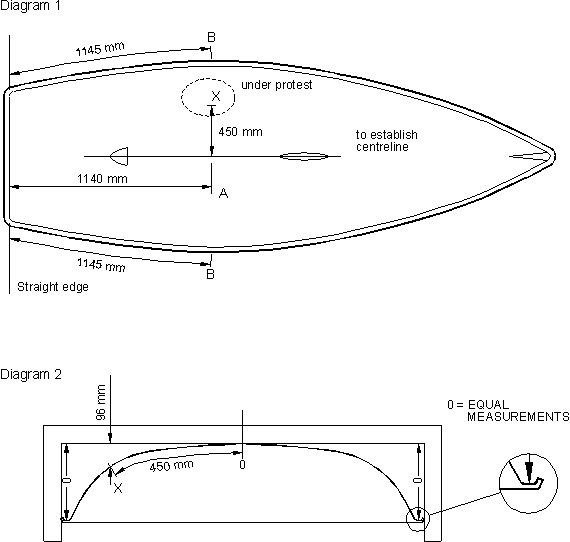
last amended 1 March 1996
| 1. | If a protest is lodged against a yacht alleging that there has been an alteration or addition thereto not permitted by the Rules of the Class, and the Race Committee, on investigation, is in doubt as to whether a violation of the Rules has occurred, it shall measure the part of yacht subject to protest in accordance with paragraph 2. | ||||||
| 2. | (a) | Hull The part of the hull of the yacht subject to protest shall be measured in accordance with the measurement directions attached as Schedule A and the same part of not less than five (5) other Lasers, chosen by the Race Committee as random samples, shall be measured in the same manner. The Race Committee shall select, if possible, Lasers which show no evidence of having been repaired or altered and which do not have inspection ports. The arithmetic mean of the measurements of the boats chosen as the sample shall be calculated, and the protested yacht shall be disqualified if the difference between the mean values so determined and the measurement on the yacht subject to protest shall exceed the following values for the measurements indicated: |
|||||
| any point along the
keel line (rocker): 2 mm any other area of the hull: 3 mm | |||||||
| (b) | Equipment If any mast, boom, fitting, centreboard or rudder is the subject of a protest as to size, shape or location, measurement thereof shall be governed by the drawings and tolerances set forth in the Measurement Diagrams (Ref: By-Law 1 - Rules) |
||||||
| 3. | This By-Law shall be read and construed in conjunction with the Rules of the International Laser Class Association and the Interpretation of the Chief Measurer, and may be amended by the World Council with the approval of the International Sailing Federation. | ||||||
This By-Law comes into
force on the 1st day of June, 1974.
Enacted by the World Council this 28th
day of April, 1974.
Schedule A to By-Law 3
| 1. | Measurement Template |
 |
| 2. | Measurement of Hull | |||||
| Turn boat upside down. Starting at the transom, measure out a distance along the keel line and establish point A, which will fall roughly athwartships of point X, the area under protest. | ||||||
| Lay a straight edge across the transom as shown in the sketch and measure out a distance along the vertical surface of the gunwale and establish point B, which will fall approximately in line with the measured point on the keel line (A) and the area under protest (X). Distances shown are as an example only. | ||||||
| The centre line of the boat must then be established at point A. This will be easy in the front one third of the boat but, to find the centre line in the aft two thirds, stretch a string over the centre of the centreboard opening and the centre of the bailer depression and extend fore and aft, as necessary. Mark the centre line at point A. Now measure from point A to point X and retain this figure to establish an equal point of measurement on the five random sample boats. | ||||||
| Place the centre of the measurement template on point A (Diagram 2), line up the vertical arms with points B and equalise exactly the distance from the horizontal bar to the inside of the gunwale on each side of the boat. | ||||||
| Measure the shortest distance from point X up to the vertical bar and record this measurement (96 mm in example). | ||||||
| This procedure should now be repeated using all the distances established above and a similar reading obtained for the distances from the hull to the horizontal cross bar on the other five sample boats. | ||||||

| Example: | Measurements on 5 sample boats: 93 + 94 + 94 + 97 + 96 | = 474 | |||
| Arithmetic mean = 474/5 | = 94.8 | Measurement on protested boat | = 96 | ||
| Difference | = 1.2 | ||||
| This does not exceed mean value by more than 3 mm, therefore protest is disallowed. | |||||
| Measurement of Rocker | ||||||
| Turn boat upside down. Measure out a distance of 3430 mm along the keel line of the boat. | ||||||
| Set up a taut string over the centre line of the boat exactly 125 mm above the keel at the transom and 85 mm above the keel at 3430 mm from the transom. | ||||||
| Measure distance along keel to point under protest (point X) and retain this figure to establish an equal point of measurement on the five sample boats. | ||||||
| Measure the shortest point from point X to the string and then repeat procedure with five sample boats. | ||||||
| Calculate arithmetic mean of the measurements from the five sample boats. Point under protest should not deviate by more than 2 mm. | ||||||
